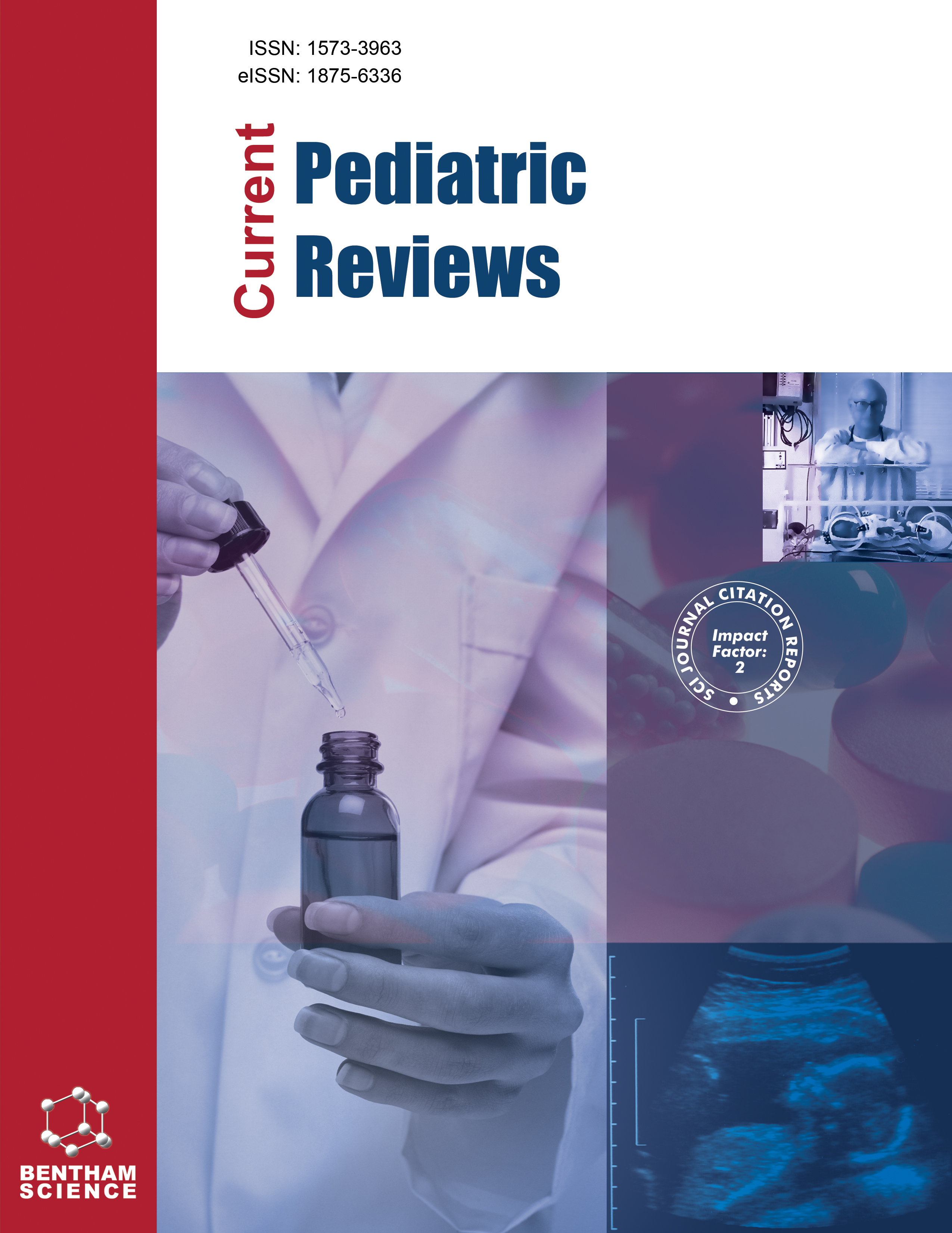- Home
- A-Z Publications
- Current Pediatric Reviews
- Previous Issues
- Volume 14, Issue 1, 2018
Current Pediatric Reviews - Volume 14, Issue 1, 2018
Volume 14, Issue 1, 2018
-
-
Approach to Pediatric Traumatic Brain Injury in the Emergency Department
More LessAuthors: Sheena Belisle, Rodrick Lim, Elena Hochstadter and Gurinder SanghaBackground: Traumatic Brain Injury is a major cause of morbidity and mortality in the pediatric population affecting millions of people yearly. It is important that practitioners have the knowledge and skills to care for these complicated patients, as the initial care can significantly affect the course of the injury. We discuss the initial management of traumatic brain injury based on mild, moderate and severe presentations. Res Read More
-
-
-
Fluid and Medication Considerations in the Traumatized Patient
More LessAuthors: Amita Misir and S. MehrotraThis article reviews fluid therapy and medications in pediatric trauma. For resuscitation in the setting of hemorrhagic shock, isotonic crystalloid solution is the first-line agent of choice. Colloid solutions offer no additional benefit, introduce possible increased risks and cost more than crystalloids. Blood products, starting with pRBCs, should be introduced after 20-40 ml/kg of crystalloid has been administered if there is Read More
-
-
-
Special Traumatized Populations: Accidental Hypothermia in Children
More LessAuthors: Shruti Mehrotra and Amita MisirPhysicians caring for children in trauma settings must consider and treat hypothermia as a cause for morbidity and mortality. Knowledge of treatment of accidental hypothermia with and without an asphyxial event is paramount. Clinicians need to identify hypothermia immediately and be aware of the overall management utilizing aggressive rewarming and cardiopulmonary resuscitation to help improve the survival of thes Read More
-
-
-
Analgesia for Children in Acute Pain in the Post-codeine Era
More LessAuthors: Naveen Poonai and Rongbu ZhuBackground: Acute pain is one of the most common presenting complaints in pediatric patients presenting to the emergency department. Recently, concern about the safety of narcotics such as codeine has sparked a renewed interest in opioids such as morphine and intranasal fentanyl. Objectives: Consequently, opioids are being increasingly used in the clinical setting. Despite this, there is ample evidence that clinicians a Read More
-
-
-
The Role of Point of Care Ultrasound in the Injured Paediatric Patient
More LessAuthors: Victor Istasy, Drew Thompson, Sheena Belisle S, Mireille Gharib and Rodrick LimThe focus of this review is to examine the current state of paediatric Point of Care Ultrasound (POCUS) in the injured patient. POCUS has become useful across various medical specialties owing to its ease of use, reproducibility and non-ionizing qualities. Point of care ultrasound has advanced over the past years and has proven to be an extremely useful adjunct in the injured child. Discussion will center around the challenges o Read More
-
-
-
Predictable and Preventable: Historical and Current Efforts to Improve Child Injury Prevention
More LessAuthors: Karen E. Forward and Eman LoubaniBackground: Childhood injuries are a global epidemic. Accidents resulting in childhood injury and death were first identified as a concern over a century ago. However, “accidents” leading to injury were not recognized as being predictable and preventable until more recently. Objectives: To describe the worldwide epidemic of childhood injuries, and look at international successes in the field of injury prevention. Methods: Liter Read More
-
-
-
Orthopedic Injuries in Pediatric Trauma
More LessAuthors: Eman Loubani, Deb Bartley and Karen ForwardBackground: Trauma remains the leading cause of death in children, of which the majority of patients have orthopedic injuries. The range of injured bones is various, each requiring knowledge and expertise to appropriately manage in a timely fashion. Objectives: The importance of a systematic approach to the pediatric polytrauma patient is paramount. This chapter will highlight orthopedic issues important to the pediatric polytr Read More
-
-
-
Pediatric Abdominal Trauma
More LessAuthors: Tim Lynch, Jennifer Kilgar and Amal Al ShibliAbdominal trauma is present in approximately 25% of pediatric patients with major trauma and is the most common cause of unrecognized fatal injury in children. Pediatric abdominal trauma is typically blunt in nature with the spleen being the most common organ injured. Nonoperative management is employed in over 95% of patients. Penetrating injuries are less common but often require operative management. Kno Read More
-
-
-
Special Traumatized Populations: Burns Injuries
More LessAuthors: Shruti Mehrotra and Amita MisirBackground: It is important for physicians treating children to be aware of unique presentations that require expertise and knowledge. One area of importance when caring for traumatized children is Thermal Burn Injuries. Burns commonly result in morbidity in children; as such, the appropriate identification of the severity of the burn and appropriate management are integral to minimize the complications of burns during the ac Read More
-
Volumes & issues
-
Volume 21 (2025)
-
Volume 20 (2024)
-
Volume 19 (2023)
-
Volume 18 (2022)
-
Volume 17 (2021)
-
Volume 16 (2020)
-
Volume 15 (2019)
-
Volume 14 (2018)
-
Volume 13 (2017)
-
Volume 12 (2016)
-
Volume 11 (2015)
-
Volume 10 (2014)
-
Volume 9 (2013)
-
Volume 8 (2012)
-
Volume 7 (2011)
-
Volume 6 (2010)
-
Volume 5 (2009)
-
Volume 4 (2008)
-
Volume 3 (2007)
-
Volume 2 (2006)
-
Volume 1 (2005)
Most Read This Month
Article
content/journals/cpr
Journal
10
5
false
en


